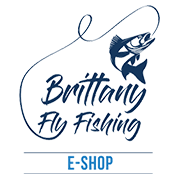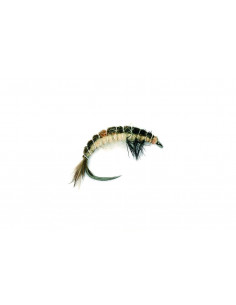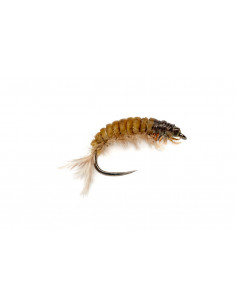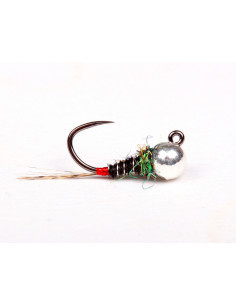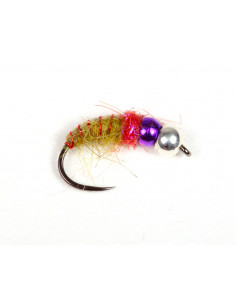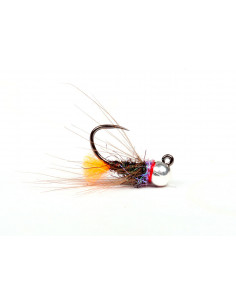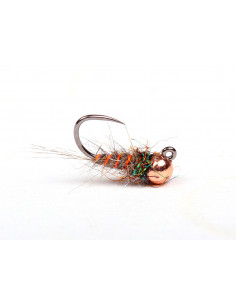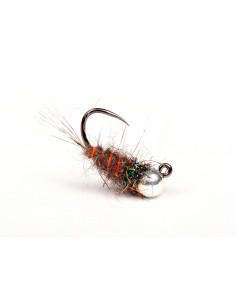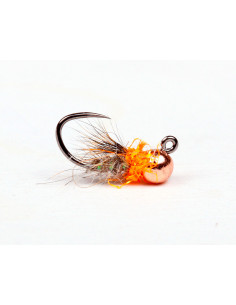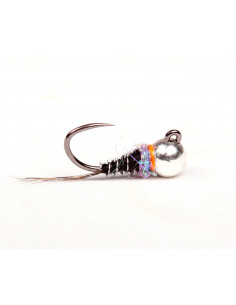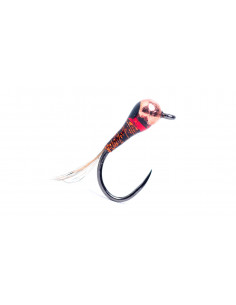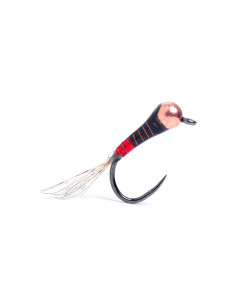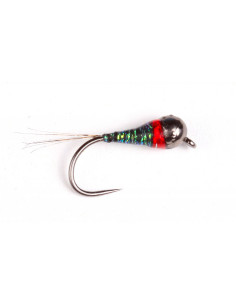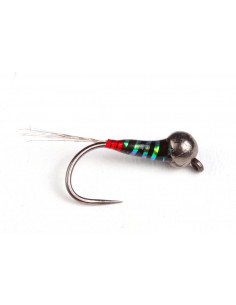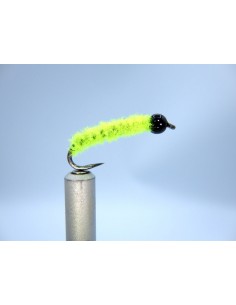Euro Nymphs
Euro Nymphs
€2.52
A realistic copy of the Hydropsyche Larva, deadly for both trout and grayling when fished Czech or French Nymph style.With a fairly slim profile, this bug sinks quickly to the fishes feeding zone.Designed by Oliver Edwards.
Oliver says '' These larvae are devoured with great relish whenever they are encountered by Trout and Grayling''.
Barbless
€2.52
A realistic copy of the Hydropsyche Larva, deadly for both trout and grayling when fished Czech or French Nymph style.With an underbody of lead and a fairly slim profile, this bug sinks quickly to the fishes feeding zone.Designed by Oliver Edwards. Ollie says ''These larvae are devoured with great relish whenever they are encountered by Trout and Grayling''.
Euro Nymphs
Guideline French Jig Nymph
€2.99
The Guideline French Jig Nymph is one of the main ‘go to’ Euro Nymph patterns for trout.
It fishes well in all conditions but can be incredibly effective in the low and clear water of mid-summer. It can be fished on its own or on a dropper as part of a multi-fly setup.Bead size 14: Silver Slotted TC 3,0mmBead size 16: Silver Slotted TC 2,4mmOur barbless...
Euro Nymphs
Guideline Blood Heart Heavy Nymph
€2.99
A heavy caddis larvae that get you deep down fast! Starting it's life in the clear streams of Bosnia, the Guideline Blood Heart Nymph is a great fly for both trout and grayling.
This fly can be used as a standalone or as a point fly when getting deep down quickly is essential.
Comes with 2 pcs. tungsten beads.
The shape of this fly is classic "czech",...
Euro Nymphs
Guideline Bootlace Orange Tag Jig Nymph
€2.99
The Guideline Bootlace Orange Tag Jig Nymph is a great pattern for those looking to target grayling. This fly is particularly effective during the autumn and winter months. It fishes well on its own or at point of a multi-fly setup. Bead size 14: Silver tungsten TC 3mmBead size 12: Silver tungsten TC 3.5mm Our barbless euronymphs are tied on hooks from...
Euro Nymphs
Guideline Czech Weapon Jig Nymph
€2.99
The Guideline Czech Weapon Jig Nymph is a fly that works extremely well during the late summer and autumn for both trout and grayling. Fished either on its own or as a dropper fly in a multi-fly setup. The copper bead with subtle hot spot rib can fool even the most pressured of fish. The shape of this fly can imitate several species of stone clinger...
Euro Nymphs
Guideline Czech Weapon Depthfinder Jig Nymph
€2.99
The Guideline Czech Weapon Depthfinder has a larger bead and is more heavy than the standard Czech Weapon. We love to use this as a point fly to make the other nymph keep their level during the drift.The color and look of the fly is just really buggy, this fly look like a lot of the food fish feed on.It can be those fat mayfly nymphs from stone clinger...
Euro Nymphs
Guideline Grayling Slayer Jig Nymph
€2.99
The idea with this fly is to have a small and heavy fly in terms of short body that get down in the water column quickly.With the mylar ribb and orange collar the fly have triggers for waking up slow fish in cold water.The Guideline Grayling Slayer Jig Nymph is a typical fly for fishing in the colder parts of the season, for autumn and winter fishing...
Euro Nymphs
Guideline Black & Purple Jig Nymph
€2.99
A leading pattern for any angler planning to fish the Euro Nymphing method. The Guideline Black & Purple Jig Nymph is a firm favourite for both trout and grayling throughout their respective seasons. A versatile fly, it can be fished alone or at any point of a three fly setup and at any depth. Bead size 14: Silver TC slotted 3,0mm Bead size 16: Silver...
Perdigons nymphs
Guideline Killer Chocolate Perdigon
€2.99
Guideline Killer Chocolate Perdigon has a brown body of holographic tinsel that matches many species darker nymphs in the river. It comes with a copper colored tungsten head and are as all our barbless euronymphs tied on quality hooks from Fasna or Hanak. A great allrounder from our Spanish Power Team Member Javier Peña that fish equally well in all parts...
Perdigons nymphs
Guideline Red Butt Perdigon
€2.99
In Spain the Red Butt Perdigon is possibly the most famous nymph used by competition anglers, they claim it's so safe you can just put this on and go fishing.
This fly is very effective in all kinds of rivers, just vary size to what kind of nymphs are present. Red Butt Perdigon is a typical generic fly for all kinds of darker mayfly nymphs and even...
Perdigons nymphs
Guideline The Favourite Perdigon
€2.99
Perdigons are part of the incentive nymphs that generate attack or feeding reactions in fish in response to a visual stimulus: shine, sparkle, intense coloured spot. The Guideline Favourite Perdigon is a fly widely used by European competition fishermen. This fly has proven to be very effective when fishing in colored water or when the river is a little...
Perdigons nymphs
Guideline Killer Red Tag Perdigon
€2.99
Perdigons are part of the incentive nymphs that generate attack or feeding reactions in fish in response to a visual stimulus: shine, sparkle, intense coloured spot. The Guideline Killer Red Tag Perdigon has a lethal combination of materials and colors. The red holographic tag and the peacock rib make it a safe bet in any type of river and time of season,...
Terrestrials dries
Drowned Willow Tree Caterpillar Nymph YLF Flies
€2.40
The Drowned Willow caterpillar Nymph YLF Flies imitates the green oak leaf roller (Tortrix viridana), a small caterpillar measuring approximately 20 mm at the end of its development, green with a black head. It is found almost exclusively on pedunculate oak trees an willow trees, where it feeds on buds and then leaves. Along riverbanks, it frequently...
